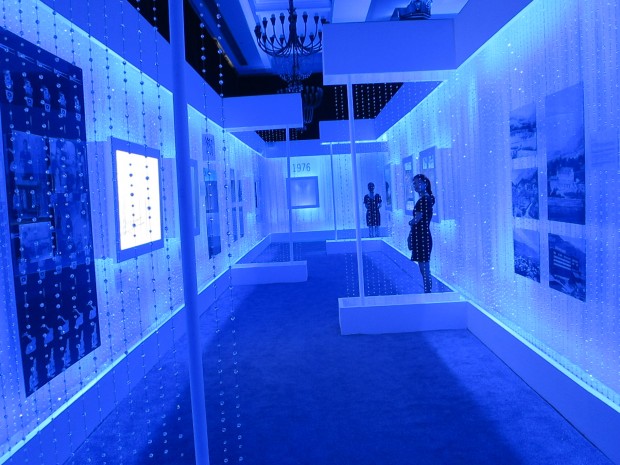
- This event has passed.
Sparkling Secrets
October 30, 2012 @ 8:00 am - 5:00 pm

Swarovski’s Sparkling Secrets exhibition debuted in Shanghai last summer, and provided visitors with an immersive dive into the famous crystal company’s century-spanning history. But the teamwork that went into creating the exhibition stands out—with a European-based client, a U.S.-based agency and creative team and an Asian venue, the challenges were many.
The team, headed by Luxe Events and EURO RSCG Worldwide, was charged with creating an environment that for the first time provided the public with a comprehensive look at Swarovski’s history, its partnerships with celebrities and fashion designers—even a peek into the brand’s creative process. Here’s a deep dive into how Sparkling Secrets was brought to life.
Beginnings
Late last year, Luxe Events pitched for the project because the agency had previous experience with the brand. Luxe Events president Thomas Serrano says the concept for Sparkling Secrets was born out of organic thinking about the project and how best to tell the brand’s story to the public.
“When we were looking at every step of the heritage of the brand, with the fashion designers and celebrities, we realized there were a lot of secrets to be revealed to those visitors. The sparkly qualities of the brand’s crystal also played into the design. ‘Sparkling Secrets’ was born. We proposed a logo and name and a number of rooms where visitors would progressively go from the heritage and introduction to the celebrity collaboration,” Serrano says.
The creative freedom in coming up with a design for the exhibition was challenging and exciting, according to Ivana Kalafatic, who was the project’s creative director.
“We did a little bit of soul searching and a lot of research [when designing the exhibition]. We did not have a specific game plan from the client, which can be thrill and it can also be a challenge, because the company started in 1895. There were many different periods of time that the company progressed through to deal with. The parameters we focused on were based on innovation, the fact that Swarovski’s founder was an entrepreneur, and that this is truly a family owned and run business. We worked closely with their archive team, and pulled out some real surprises,” Kalafatic says.
Irma Hardjakusumah served as design director for the project, and took inspiration from the client’s goals for the exhibition.
“This is the first time the brand has done an exhibit that actually touches on their heritage. You see a lot of Swarovski installations and they usually focus on the phenomenon of the crystal and its power in transforming light, and there are great artists who have made many, many beautiful installations that are Swarovski-based. What corporate wanted to do was create a global exhibit that touched on several points, and the brand’s collaboration with designers and movie stars would be in focus. They want to tell the story of how they started, and tell the entire story,” Hardjakusumah says.
Experience
Visitors entered into a timeline zone called the Crystal Maze. This was a three-dimensional timeline with a video wall showing crystal imagery, which led visitors into a blue room with a series window displays built into the walls. Inside the boxes, key dates in Swarovski history were brought to life.
As visitors weaved through the crystal curtains to see the stories told inside the boxes, they were able to learn more about the brand through pictures, graphics, videos and Swarovski crystals.
“Each of the products and milestones of the company are included in the window boxes. You walk through the timeline, you understand where they started, and then you get a feeling of their world,” Hardjakusumah says.
Leaving the timeline area, visitors entered the Swarovski Hall of Fame. The Hall of Fame focuses on all of Swarovski’s collaborations with music stars and celebrities including Madonna, Lady Gaga, Jennifer Lopez, Britney Spears and Audrey Hepburn.
The showcases in this area focused on the stars and the crystal-laden creations, as the content really spoke for itself.
“When you have the bra from Madonna you don’t need to do much—you just display it beautifully and everybody is going to stop and look at it,” Serrano says.
The famous ruby slippers from “The Wizard of Oz” ruby slippers were actually Swarovski, but designers were having trouble securing the actual shoes for the exhibit, so they used technology to help them out. As part of an augmented reality-style interactive, visitors stood on a platform in front of a mirrored surface, triggered a button and the famous ruby slippers appear on their feet.
“I think for a lot of consumers, their favorite was the Hall of Fame because everyone loves celebrities and learned more about Swarovski,” says project manager Jennifer Baker.
The next destination for visitors was the Creative Lab, where they were introduced to the world of the Swarovski creative team, headed by Paris-based creative director Nathalie Colin.
“She designs a lot of Swarovski’s jewelry line in her Paris office. This is her world, and we showcased her creative process, her team, what they do, her inspiration. We did a mock-up of her actual office in Paris,” Hardjakusumah says.
Also included in the Lab was a drawing table with paper and pens where people could design something and put it in the P.O. box on the table. After the exhibition is over, Colin will pick the design she likes best and actually create it out of Swarovski crystal.
